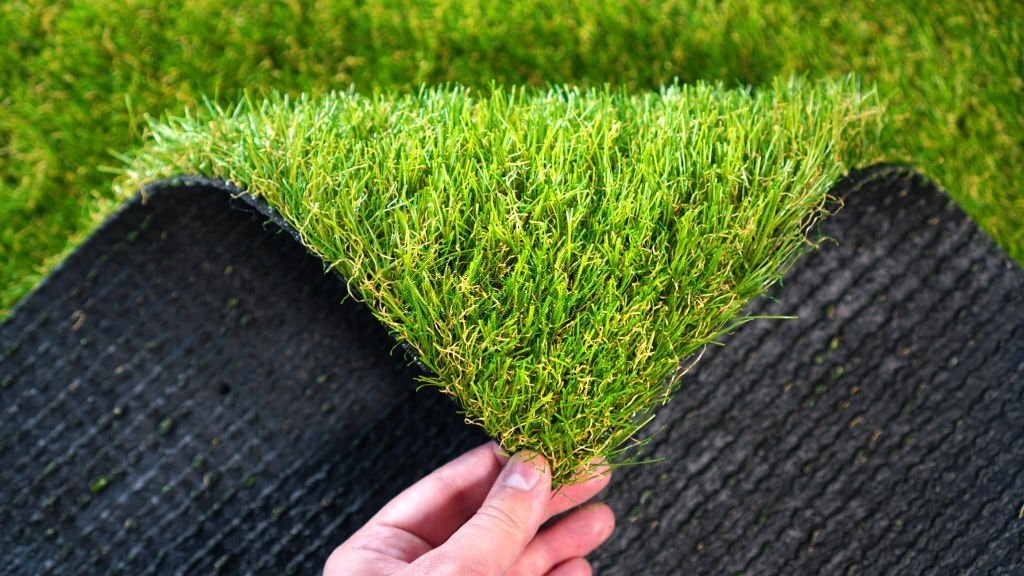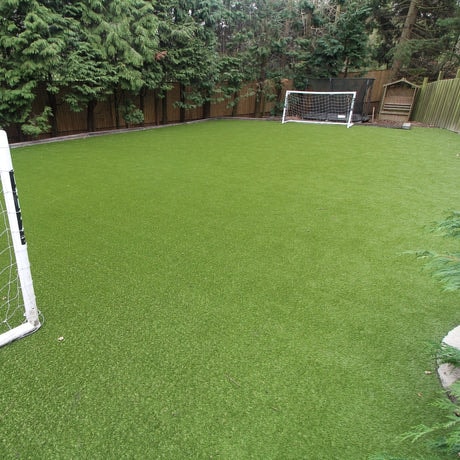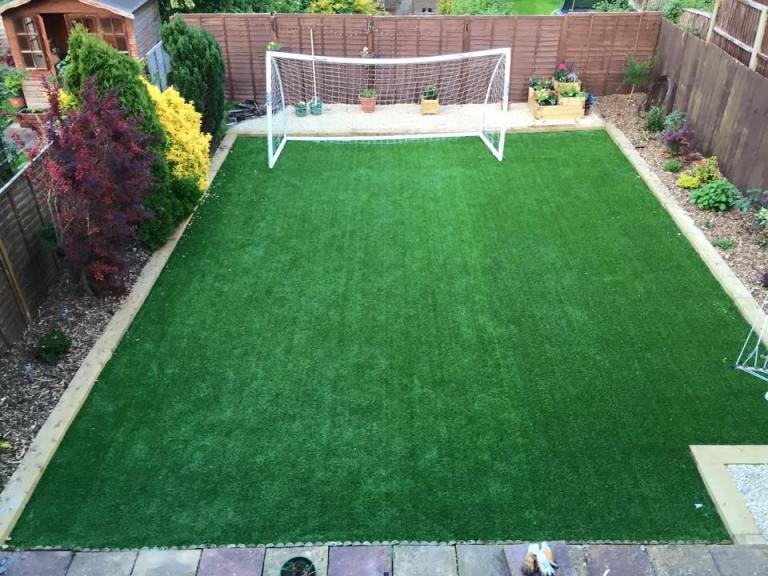Having a football pitch in your garden provides training opportunities for both professionals and enthusiasts, allowing them to enhance their skills without relying on external sports facilities.
The advent of synthetic turf has made it more convenient than ever to establish a robust, low-maintenance football or mini football pitch in your backyard, offering enjoyment for the whole family. Gone are the days when players had to settle for the uneven surfaces of local parks or the crowded and costly training centres.
This article will provide insightful tips on planning and designing your pitch, detailing the steps for turf preparation and installation, as well as offering maintenance advice to ensure it remains in top condition for years.
Types of Astro Turf Football Pitch

Before delving into the design and installation steps, it's crucial to understand the different types of football turf available. Astro turf systems for garden pitches are far more than just artificial grass; they are sophisticated, technologically advanced fibres crafted to optimize player performance. There are primarily two standards of turf designed for football, determined by the specific playing and certification requirements needed.
These turf systems have specific sub-base requirements, such as infill and shock layer thickness, needed for professional football. In contrast, recreational football has fewer criteria, making it a suitable and cost-effective option for garden pitches, which simplifies the installation process.
2G Football Turf
2G, or second-generation, football turf consists of short, dense fibres with a sand infill and is widely used in school and community football as well as different sports. It provides a natural look and feel, making it a popular choice for garden football pitches. However, it may require more maintenance compared to 3G turf.
3G Football Turf
3G, or third-generation, football turf is characterized by its longer fibres combined with a sand and rubber infill. This type of synthetic grass provides superior shock absorption, making it ideal for garden mini pitches that are used for intensive training and frequent play.
Key Differences:
- Durability: 3G turf is highly durable and ideal for areas that experience heavy foot traffic.
- Maintenance: 2G turf often needs regular brushing or raking to preserve its appearance, along with replenishing the sand infill.
- Cost: 3G turf typically costs more because of its superior features.
Designing Your Turf Garden Football Pitch - Steps involved in Making a Back Garden Football Pitch

Create an astro turf pitch with these straightforward steps. Numerous online guides offer professional design assistance, ranging from basic layouts to European football championship outlines, which are excellent for determining the scale and dimensions of various garden pitch options.
Alternatively, you can hire an experienced astro football pitch installer who can handle ground preparation, install a weed membrane, and construct a solid sub-base.
Planning
-
Measure the Area: Assess the dimensions of your garden football pitch. A mini pitch generally measures about 30m by 20m, but you can modify these measurements based on your space and specific needs.
-
Choose the Turf: Choose between 2G and 3G artificial grass by considering your budget and usage requirements. Additionally, determine if you want to include a shock layer, which is a closed-cell foam that enhances shock absorption and player safety.
-
Prepare the Sub-base: The usual construction for a 2G grass sub-base includes the following layers:
1. Synthetic Grass
2. Silica Sand & Rubber Infill
3. 10mm or 12mm Shock Pad
4. 50mm Layer of Blinding
5. 200mm layer of stone type 3"
6. Geotextile membrane
7. 80mm diameter land drain
Installation
-
Lay the Base: Incorporate a layer of crushed stone or grit to establish a stable foundation for your astro turf football pitch.
-
Shock Pad Layer: Install the shock pad layer, which is advised for increased safety and improved playability.
-
Install the Edging: Define the boundaries of your football pitch using treated timber or plastic edging.
-
Lay the Artificial Grass: Lay the artificial grass over the prepared base, making sure it fits snugly against the edges.
-
Infill: Distribute sand or a mixture of sand and rubber infill across the turf to add weight and support the fibres.
-
Markings: Use tape to outline the football court markings, then apply specialist synthetic grass paint to finish the pitch lines.
-
Accessories: Consider investing in features like goalposts to achieve a complete pitch setup.
Maintaining Your Artificial Grass Football Pitch

Keeping your garden football pitch in good condition is much simpler than maintaining natural grass. Here are some helpful tips:
-
Regular Cleaning: Clear away leaves, debris, and any other foreign objects from the surface.
-
Brushing/Raking: Use a stiff brush or rake to keep the artificial grass fibres upright, particularly in high-traffic areas.
-
Infill Top-up: Regularly check and replenish the infill to maintain the pitch’s level, upper soil stability, and resilience.
-
Deep Cleaning: For a more thorough clean, wash the turf with a mild detergent and water solution, then rinse with fresh water.
Benefits of a Garden Football Pitch
Installing a new artificial grass pitch offers significant advantages, including year-round usage, enhanced playability, and the opportunity to improve football skills through dedicated practice at home. Let's explore these benefits in more detail.
- Low Maintenance: Unlike natural grass, artificial turf requires minimal upkeep, eliminating the need for regular mowing, weeding, and fertilizing.
- Authentic Look: Astroturf mimics the look and feel of natural grass, offering a lush, dark green appearance and high comfort, perfect for playing football in the garden.
- Durability: Designed to withstand heavy use while maintaining its condition for years.
- All-Weather Play: Equipped with drainage systems, it allows for play in any weather.
- Safe and Comfortable: Provides a cushioned surface that minimizes the risk of injuries.
- Versatility & Inclusivity: Transforms your backyard into a sports space for the entire family to enjoy anytime.
- Encourages Exercise & Goal Setting: A home football pitch can motivate young athletes and sports enthusiasts to train and set personal goals.
FAQ
Is there a higher risk of footballers injuring themselves or slipping on artificial grass?
No artificial grass is designed to have the perfect blend of resilience and traction needed for football.
Is a turf football pitch comfortable?
Yes turf pitches are made with comfort in mind and together with the recommended sub base system and shock pad layer provides the highest quality game experience.
What are the temperatures like in summer with fake grass?
Artificial turf is excellent for staying neutral during hot weather as well as colder weather conditions and is UV resistant. The sun will not affect it's peformance or aesthetic.
When installing your fake grass do you use a layer of sharp sand or silica sand?
Silica sand is recommended for installing astroturf as it is finer.
Do you need a specialist to lay your artificial grass?
No you don't require a specialist installer, however if you don't have prior experience or knowledge it is recommended.
Conclusion
Transforming your garden into a mini football pitch with artificial grass provides a convenient and durable solution for practice and training. Whether you decide to dedicate a small area or your entire backyard, synthetic turf offers a low-maintenance, all-weather playing surface that can be enjoyed year-round.
From the initial planning and installation to the final touches of adding goalposts and marking pitch lines, follow these steps to turn your outdoor space into a ready-to-use astro turf football pitch.
Browse our range of grass garden football pitch solutions here.
FAQs
What are the advantages of artificial grass football pitches for football clubs?
Football clubs often prefer artificial grass football pitches due to their durability and low maintenance requirements. Unlike natural grass pitches, artificial turf pitches can withstand extensive use without deteriorating, making them ideal for both training and competitive matches. This consistency ensures that games are rarely disrupted by weather conditions, providing a reliable playing surface year-round.
How do synthetic football pitches compare to natural turf pitches in terms of performance?
Synthetic football pitches offer a consistent playing surface compared to natural turf pitches, which can be affected by weather and wear. Artificial football pitches provide uniform traction and ball bounce, enhancing the overall quality of play. While natural grass pitches offer a traditional feel, artificial turf football pitches are engineered to closely mimic these characteristics, providing an excellent alternative with added durability.
What maintenance is required for artificial turf football pitches?
Artificial turf football pitches require significantly less maintenance than natural grass pitches. Routine tasks include brushing to maintain the turf's upright position, checking for debris, and ensuring proper infill levels. These maintenance practices help preserve the quality of the artificial football pitch, extending its lifespan and ensuring a safe playing environment.
Why might football clubs choose artificial pitches over natural ones?
Football clubs might opt for artificial pitches as they offer greater resilience and cost-effectiveness over time. Artificial grass pitches require less water, fertilizers, and mowing compared to natural turf pitches, resulting in reduced operational costs. Additionally, artificial pitches allow for more frequent usage without degradation, making them an attractive option for clubs looking to maximize field availability.




















